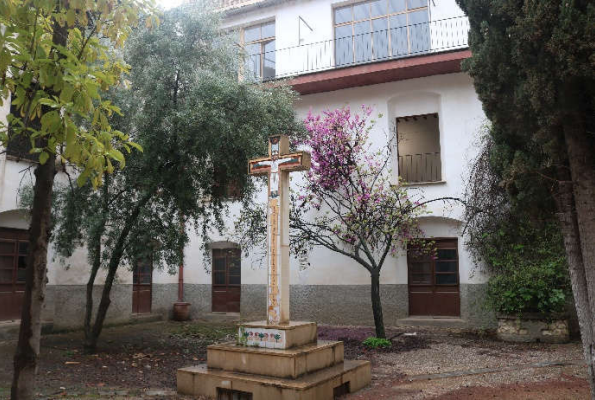5 minutos de lectura
Discover all the Convents of Caravaca de la Cruz
Por: Turismo Región de Murcia en 9/11/24 9:52 AM

Former Jesuit school
The former Jesuit school, a site that blends religious heritage with cultural spaces, is one of the most iconic locations in Caravaca. Although the cloister of the school is currently under restoration, the site remains a key landmark in the city. Founded by the Jesuit order, this school served as an important center of education and spirituality for centuries. The church, once dedicated to Our Lady of the Annunciation, is now a cultural venue hosting various activities and exhibitions, keeping the Jesuit tradition of learning alive. This site is a prime example of how a religious building can be adapted to modern times without losing its historical essence.

Church of San José - Convent of San José of the Discalced Carmelites
The Convent of San José of the Discalced Carmelites is one of the most special monuments in Caravaca, both for its historical significance and for the recent renovations that have enhanced its appeal as a tourist destination. Founded by St. Teresa of Jesus at the end of the 16th century, this convent has been a vital spiritual center for more than four centuries. In 2021, it was acquired by the local community to ensure its preservation and unlock its potential as a cultural site.
The complex includes the Church of San José, the old convent, the House of the Mandaderas, and its orchard. Monthly guided tours, with upcoming dates on September 13 and October 11, 2024, offer visitors the chance to discover the hidden wonders of this place. Recent historical and archaeological studies have shed new light on the evolution of the convent complex, highlighting important features such as the House of the Mandaderas.
Convent of Santa Clara
The Monastery and Church of Santa Clara are another jewel of Caravaca de la Cruz’s religious heritage. This 17th-century convent is inhabited by a community of cloistered Poor Clare nuns. Built on the site of the medieval Hermitage of San Bartolomé, the convent is a place of great beauty and serenity. The architecture, with its simple yet imposing facade, reflects the austerity and devotion of the Poor Clare order. While the cloister is closed to the public, the presence of the nuns and the history of the site ensure that the Convent of Santa Clara remains a place of deep spirituality. However, the church of Santa Clara can be visited each morning until midday, when the Blessed Sacrament is exposed.

Convent of Santa María de Gracia, Franciscans
In one of the higher parts of the town once stood the convent of the Franciscan friars, dedicated to Our Lady of Grace. It was the first religious order to express an intent to establish itself in Renaissance Caravaca in the early 16th century, but various circumstances caused the Jesuits and Carmelite orders to precede them. Finally, in 1571, they erected their convent and monumental church in the neighborhood that still bears their name, San Francisco.
The friars were responsible for worship at the Church of Santa Clara (also of Franciscan order) and several rural hermitages, and they even established a chair of Philosophy and Morals at their convent. The confiscations of the 19th century marked the end of this foundation, and after the Franciscans were expelled, the convent deteriorated until it was demolished to make way for the current Plaza de Toros of Caravaca. However, some architectural remnants of the convent still remain, visible on the exterior of the bullring.
Convent of Our Lady of Carmen, Discalced Carmelite Fathers
Saint John of the Cross, the mystic saint, patron of Spanish poetry and contemplatives, and a universal figure of religion, personally founded this convent in 1587. After the foundation of the San José Convent of the Discalced Carmelites in Caravaca, Father John of the Cross frequently visited the nuns at the request of Mother Teresa of Jesus. On one of these visits, he learned that the Carmelite nuns wished to have their Carmelite brothers nearby, prompting the saint to seek and obtain permission for the foundation, which he successfully completed.
The Discalced Carmelite Fathers were always beloved and popular, being deeply involved in the daily and cultural life of Caravaca. Today, after two suppressions throughout history, the convent of Carmen is self-sustaining thanks to the guesthouse the friars run, and they sponsor the “Albacara” literature prize and the “San Juan de la Cruz” mystical poetry award. Interestingly, the conventual church of Carmen was designed by the same master builder of the Sanctuary of Vera Cruz in Caravaca, Brother Alberto de la Madre de Dios, also a member of the Carmelite order. Along with Segovia, Caravaca de la Cruz is one of the only cities in Spain with a double foundation of Discalced Carmelites.

Convent of San Jerónimo
The Jeronimite fathers arrived in Caravaca in 1582, establishing a house in a location only known as "Trascastillo," likely today’s Barranco de San Jerónimo. A few years later, a benefactor named Jacopo Bracamonte donated a house near the fountain where the Templete or Bath Chapel now stands.
The Jeronimites did not take an active part in the public life of the town, but they played an invaluable role as caretakers of orphans and abandoned children. Like many other orders, the Jeronimites were affected by the confiscations of the 19th century and were expelled from their convent in 1836. The building then served private purposes until it was acquired by the municipality in the late 20th century to house the current Casa de la Cultura. The only visible remnant of the Jeronimite monastery is a small stone relief of Saint Jerome above the door on the right facade of the building.
In conclusion, the convents of Caravaca de la Cruz are much more than religious buildings; they are witnesses to the history, faith, and culture of the region. Each one has its own unique story and features that make it special, and visiting these sites offers an opportunity to connect with centuries of devotion and discover the profound spirituality that defines this city.
What makes the Caravaca Cross so special
The Christian religion is characterized by its rich iconography, where various visual symbols...
The best places to visit around Caravaca de la Cruz
Caravaca de la Cruz has many places to visit, especially sites of great historical and cultural...

